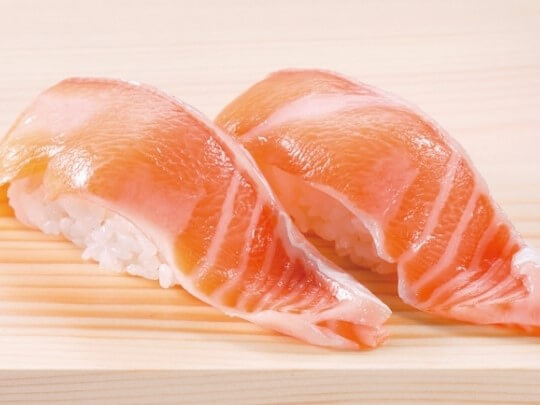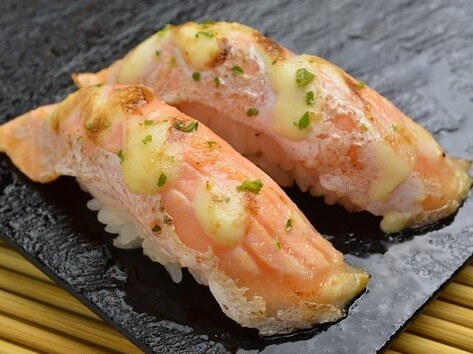 You probably already know this, but “toro tuna” is not the name of a type of fish. “Toro” is the name of a fatty part of the tuna. The fat content and attributes of the belly side of the tuna are completely different from that of the dorsal side. Toro is the name of the part near the head, mostly on the belly side.
You probably already know this, but “toro tuna” is not the name of a type of fish. “Toro” is the name of a fatty part of the tuna. The fat content and attributes of the belly side of the tuna are completely different from that of the dorsal side. Toro is the name of the part near the head, mostly on the belly side.
In the same way, there is no fish called “toro salmon”. Just like tuna, “toro” refers to the fatty part on the belly side of the salmon. It is also called “harasu” in Japanese. This is how the word is used at some scrupulous sushi restaurants. This description of “toro salmon” is correct.
Most salmon used at conveyor belt sushi restaurants is either trout salmon or Atlantic salmon. The reason this salmon can be served at the cheap price of US $1 or $2 per plate (2 pieces of sushi) is that these particular fish are all farmed and are available in bulk quantities from overseas. This salmon is mainly imported to Japan from Norway, Chile, Scotland and Canada.
Actually, the popular “toro salmon” topping is made from these imported items and the fat content is three times that of wild salmon. Feeding farmed salmon plenty of solid compounded feed that is high in protein and high in fat, turns the entire body to toro.
Salmon, which are born in freshwater and migrate downstream to the sea are called “sea-run fish” and they may be farmed in either seawater or freshwater. Trout salmon is “former” rainbow trout that was raised in a fish cage in the sea. In the wild, the sea-run rainbow trout grows up to 1 m in length, its body turns silver and the meat takes on a red color. The wild version of these are called “steelhead” and fetch a high market price, so they are not used in conveyor belt sushi restaurants.
Just like other aquaculture, salmon farming faces some difficult issues. It may surprise you that salmon is actually a white fish, originally. In the wild, the salmon meat gets a red color from feeding on crustaceans such as crab and shrimp that contain the red pigment astaxanthin. However, in the fish cages where the salmon are surrounded by nets, the food chain is also restricted. The compound feed would be plenty if the goal was only to raise bigger fish, but that results in a grey color or light yellow meat that doesn’t even resemble the salmon pink (orange?) that everyone wants and they don’t sell.
Therefore, when making the solid compounded feed, artificial coloring is mixed in. One of the colorings is called canthaxanthin. This is a synthetic chemical derived from petroleum. There is a color chart with 10 different, detailed levels of red coloring and buyers can even indicate which color they would like and the farmers can achieve it. It’s kind of like an industrial product that is being manufactured. Japanese people prefer a dark red color for salmon in the same way they do for tuna, so the coloring for Japan’s market is adapted to that.
When light is shone on wild salmon, the red coloring looks faded, but the light makes farmed salmon that have been fed coloring, look brighter. Artificial coloring is a necessity in farmed salmon and this is true for the trout salmon and Atlantic salmon that are used as the ingredients for toro salmon as well. All of the farmed salmon in circulation have been colored in this way, so much so that it wouldn’t be surprising if the insides of their stomachs were stained red. The flamingos at zoos also get their beautiful pink feathers from these chemicals.
Trout salmon is rainbow trout that has been farmed in the sea. On the other hand, rainbow trout farmed in freshwater is called Donaldson trout. Of all the large rainbow trout gathered at each location, those with small heads and fat bodies were selected and bred over many years to create this type. The objective of choosing a small head is to make more meat. They are characterized by their fast growth and while normal, farmed rainbow trout grow to about 30 to 40 cm, Donaldson trout grow up to nearly 1 m. The name is taken from the American who developed this variant.
 The Donaldson trout is farmed throughout Japan and is used as toro salmon and aburi salmon at conveyor belt sushi restaurants. Since they are supplied directly to the processor (of the salmon) from the farmer without going through the market, they may be sold cheaper than the import price. Just like the imported salmon, this farmed salmon is also fed artificial coloring. There are also already new variants improved from the Donaldson trout being bred. Trout made from breeding Donaldson trout females and steelhead males are called Donaldson steelhead, for instance. They grow even faster.
The Donaldson trout is farmed throughout Japan and is used as toro salmon and aburi salmon at conveyor belt sushi restaurants. Since they are supplied directly to the processor (of the salmon) from the farmer without going through the market, they may be sold cheaper than the import price. Just like the imported salmon, this farmed salmon is also fed artificial coloring. There are also already new variants improved from the Donaldson trout being bred. Trout made from breeding Donaldson trout females and steelhead males are called Donaldson steelhead, for instance. They grow even faster.
Ample use of the latest biotechnology has been made in salmon farming and some of these technologies include creating young fish without functioning reproductive organs, “triploids” which means increasing the size of the fish up to triple and “all female populations” where males are converted into females. The triploid fish grow large in correlation to the lack of energy exertion. The objective of all-female populations is to get more masuko (ovaries). Masuko is used for the ikura (salmon roe) at conveyor belt sushi, and since the fish that the roe is harvested from have an inferior flavor, they are used for aburi salmon. Now, there are even triploid, all-female farm populations. No wonder the restaurants can serve a plate (2 pieces) of salmon sushi for US $1.
The simple phrase, “toro salmon” contains so much meaning.
[sc_apply url=”https://sushiuniversity.jp/apply/”]
Related contents:
We hope this information will be helpful.

Revision date: February 16, 2023
Share this article